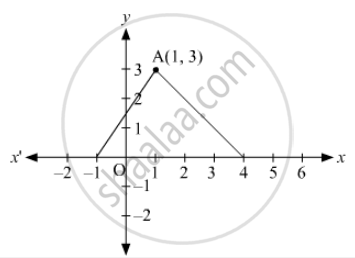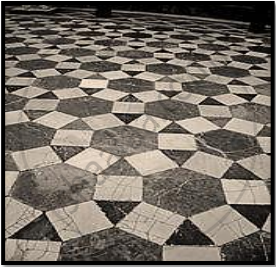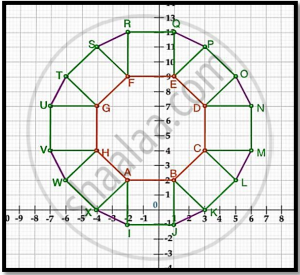Advertisements
Advertisements
प्रश्न
The coordinates of a point on x-axis which lies on the perpendicular bisector of the line segment joining the points (7, 6) and (−3, 4) are
विकल्प
(0, 2)
(3, 0)
(0, 3)
(2, 0)
उत्तर
TO FIND: The coordinates of a point on x axis which lies on perpendicular bisector of line segment joining points (7, 6) and (−3, 4).
Let P(x, y) be any point on the perpendicular bisector of AB. Then,
PA=PB
`sqrt((x -7)^2 + (y -6)^2) = sqrt((x-(-3))^2+(y-4)^2)`
`(x-7)^2+ (y - 6)^2 = (x +3)62 + (y-4)^2`
`x^2 - 14x + 49 +y^2 - 12y +36 = x^2 +6x +9 +y^2 -8y + 16`
-14x - 6x - 12y - 8y + 49 +36 -9 - 16 = 0
- 20x + 20y + 60 = 0
x - y - 3 = 0
x - y = 3
On x-axis y is 0, so substituting y=0 we get x= 3
Hence the coordinates of point is (3,0) .
APPEARS IN
संबंधित प्रश्न
Find a point on y-axis which is equidistant from the points (5, -2) and (-3, 2).
Prove that the points A(-4,-1), B(-2, 4), C(4, 0) and D(2, 3) are the vertices of a rectangle.
If the points A (a, -11), B (5, b), C (2, 15) and D (1, 1) are the vertices of a parallelogram ABCD, find the values of a and b.
Show that the following points are the vertices of a rectangle
A (0,-4), B(6,2), C(3,5) and D(-3,-1)
The base QR of a n equilateral triangle PQR lies on x-axis. The coordinates of the point Q are (-4, 0) and origin is the midpoint of the base. Find the coordinates of the points P and R.
If the vertices of ΔABC be A(1, -3) B(4, p) and C(-9, 7) and its area is 15 square units, find the values of p
Find the coordinates of the centre of the circle passing through the points P(6, –6), Q(3, –7) and R (3, 3).
If the points A(−1, −4), B(b, c) and C(5, −1) are collinear and 2b + c = 4, find the values of b and c.
If the points A(1, –2), B(2, 3) C(a, 2) and D(– 4, –3) form a parallelogram, find the value of a and height of the parallelogram taking AB as base.
Write the formula for the area of the triangle having its vertices at (x1, y1), (x2, y2) and (x3, y3).
What is the distance between the points A (c, 0) and B (0, −c)?
If points (t, 2t), (−2, 6) and (3, 1) are collinear, then t =
The length of a line segment joining A (2, −3) and B is 10 units. If the abscissa of B is 10 units, then its ordinates can be
In Fig. 14.46, the area of ΔABC (in square units) is

If P(2, 4), Q(0, 3), R(3, 6) and S(5, y) are the vertices of a parallelogram PQRS, then the value of y is
The line segment joining the points A(2, 1) and B (5, - 8) is trisected at the points P and Q such that P is nearer to A. If P also lies on the line given by 2x - y + k= 0 find the value of k.
Find the coordinates of point A, where AB is a diameter of the circle with centre (–2, 2) and B is the point with coordinates (3, 4).
Point (–3, 5) lies in the ______.
In which quadrant, does the abscissa, and ordinate of a point have the same sign?
A tiling or tessellation of a flat surface is the covering of a plane using one or more geometric shapes, called tiles, with no overlaps and no gaps. Historically, tessellations were used in ancient Rome and in Islamic art. You may find tessellation patterns on floors, walls, paintings etc. Shown below is a tiled floor in the archaeological Museum of Seville, made using squares, triangles and hexagons.

A craftsman thought of making a floor pattern after being inspired by the above design. To ensure accuracy in his work, he made the pattern on the Cartesian plane. He used regular octagons, squares and triangles for his floor tessellation pattern

Use the above figure to answer the questions that follow:
- What is the length of the line segment joining points B and F?
- The centre ‘Z’ of the figure will be the point of intersection of the diagonals of quadrilateral WXOP. Then what are the coordinates of Z?
- What are the coordinates of the point on y-axis equidistant from A and G?
OR
What is the area of Trapezium AFGH?
